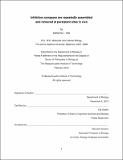Inhibitory synapses are repeatedly assembled and removed at persistent sites in vivo
Author(s)
Villa, Katherine L. (Katherine Leigh)
DownloadFull printable version (5.495Mb)
Other Contributors
Massachusetts Institute of Technology. Department of Biology.
Advisor
Elly Nedivi.
Terms of use
Metadata
Show full item recordAbstract
Structural plasticity, the rewiring of synaptic connections, occurs not only during development, but is prevalent in the adult brain and likely represents the physical correlate of learning and memory. Removal or addition of excitatory and inhibitory synaptic inputs onto a neuron can affect their relative influence on excitation in specific dendritic segments, and ultimately regulate neuronal firing. However, the structural dynamics of excitatory and inhibitory synapses in vivo, and their relation to each other, is not well understood. To gain insight into synaptic remodeling in the adult brain in vivo, we used dual- and triple- color two-photon imaging to track the dynamics of all inhibitory and excitatory synapses onto a given neuron in the cerebral cortex at different timescales. By studying synaptic changes over 4-day or 24-hour intervals we were able to determine that inhibitory synapses are remarkably dynamic in vivo. We found that Inhibitory synapses occur not only on the dendritic shaft, but also a significant fraction is present on dendritic spines, alongside an excitatory synapse. Inhibitory synapses on these dually innervated spines are remarkably dynamic and in stark contrast to the stability of excitatory synapses on the same spines. Many of the inhibitory synapses on dendritic spines repeatedly disappear and reappear in the same location. These reversible structural dynamics indicate a fundamentally new role for inhibitory synaptic remodeling - flexible, input-specific modulation of stable excitatory connections. To determine whether synapse dynamics are regulated by experience-dependent plasticity, we performed monocular deprivation, finding that an ocular dominance shift reduces inhibitory synaptic lifetime and increases recurrence. To investigate the molecular mechanism of rapid inhibitory synapse appearance and removal, I am currently testing molecular interventions that influence the clustering of gephyrin, a scaffolding molecule that anchors inhibitory receptors at postsynaptic sites.
Description
Thesis: Ph. D., Massachusetts Institute of Technology, Department of Biology, 2016. This electronic version was submitted by the student author. The certified thesis is available in the Institute Archives and Special Collections. Cataloged from student-submitted PDF version of thesis. "February 2016." Includes bibliographical references (pages 113-123).
Date issued
2016Department
Massachusetts Institute of Technology. Department of BiologyPublisher
Massachusetts Institute of Technology
Keywords
Biology.